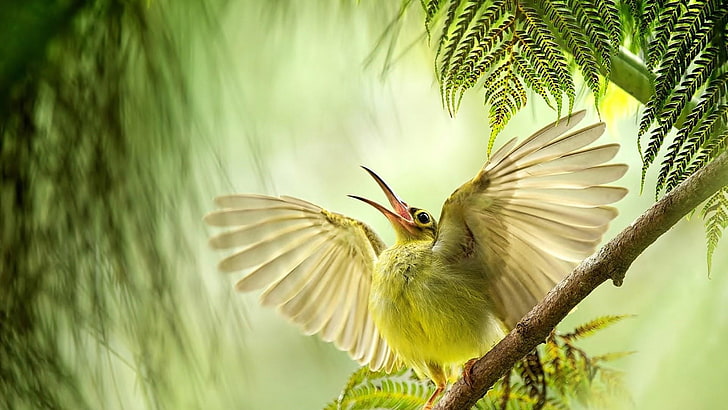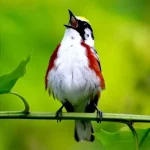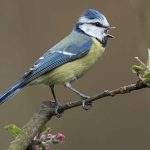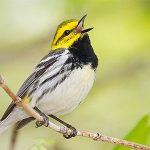Why do birds of the same species sing in a harmonious symphony, creating a unique and shared language that transcends individuality within their avian community?
Why Do Birds Of Same Species Sing The Same Way
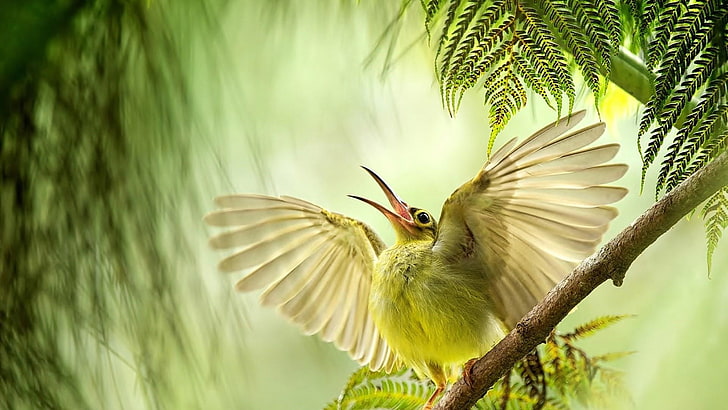
Ever thought about why birds of the same type sing similarly? Well, it’s because of their genes, how they’re brought up, and this thing called ‘culture.’
Birds of the same species, having similar genetic blueprints, inherently produce analogous sounds. Learning and Upbringing: Just like how human children learn a language, birds too learn their ‘songs’ from adult ‘tutors’.
Just like people have their own way of talking, birds have their own ‘language‘ that they pass down from one generation to the next. Their songs aren’t just for fun – they actually say important stuff. Whether it’s finding a partner, marking their space with musical boundaries, or warning about dangers, each chirp has a job.
In this blog, let’s explore why birds sing together. We’ll check out the interesting things birds do and find out why their songs are so special. Get ready to learn about the funny habits of our feathered pals and the cool reasons behind their catchy tunes.
Table Of Contents
Birds: Nature’s Rockstars
Decoding Bird Chatter: A Journey into Feathered Conversations
The Symphony of Avian Communication: Unlocking the Intricacies of Bird Songs
Mate Attraction: The Love Serenade
Territory Defense: The Battle of Beats
Cultural Transmission: The Songline Legacy
Predator Warnings: The Chorus of Caution
Wrapping it Up with a Feathered Twist
FAQs: – Why Do Birds Of Same Species Sing The Same Way?
Birds: Nature’s Rockstars
Dive into the awesome world of birds, the rockstars rocking the nature symphony. Their tunes, like a catchy song, ring out in our surroundings. Ever wondered why birds of a certain gang seem to share the same playlist? It’s not just random – there’s a cool science to their synced-up tunes, and their chirps are no accident – there’s some serious purpose and flair in how they sing.
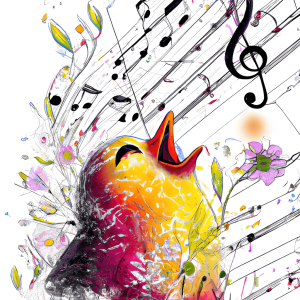
The Genetic Jam:
Each bird gang has its own set of genetic rules, like a musical script written in their DNA. This genetic code shapes not just how they look and act but also crafts the cool songs they sing.
Birds of the same crew, working with the same genetic vibes, naturally belt out similar sounds, creating a smooth musical connection.
Learning and Jamming:
Kinda like how kids pick up language, birds go through a musical boot camp. Baby birds spend hours soaking in the wisdom of their bird mentors.
During this groove session, they carefully tweak their voices, copying the jams of their older bird pals. This learning process keeps the party going with the same tunes, making a rad legacy of shared beats within the crew.
Decoding Bird Chatter: A Journey into Feathered Conversations
Ever wondered about the secret language of birds? It’s like cracking a code where each bird species creates its own unique musical community.
Musical Traditions:
Birds of the same type share a kind of ‘musical tradition.’ Each species has its special set of songs, creating a sort of bird culture. This musical culture helps them talk to each other effectively and keeps their communication consistent within their group.
Regional Twists:
Believe it or not, bird songs also have ‘accents‘ or ‘dialects.’ If you have different groups of the same bird species living far apart, their songs might sound a bit different. It’s like how people from different places have unique ways of speaking. This adds a cool layer to bird communication, making it as diverse as the world of human languages.

The Symphony of Avian Communication: Unlocking the Intricacies of Bird Songs
In the grand tapestry of nature, where each thread weaves a story of survival and adaptation, bird songs emerge as a captivating melody that resonates through the ages. Beyond the surface simplicity of their tunes lies a complex symphony, intricately linked to the survival, reproduction, and communal harmony of our feathered companions.
Mate Attraction: The Love Serenade
Picture this: a lush forest adorned with vibrant plumage and melodious tunes. In this enchanting realm of courtship, bird songs become the sweet serenade that orchestrates the dance of love. It’s not merely about the musicality; it’s a communication method essential for the continuation of the species.
Within a species, birds share a common musical language, a repertoire of tunes that serves as a bonding agent during courtship. Understanding and effectively delivering these melodies is not just an artistic display but a vital skill that hints at genetic prowess and the promise of robust offspring. Females, the discerning critics of this avian musical, are drawn to males who can skillfully perform their species-specific tunes.
In essence, these avian love ballads are a testament to the significance of shared culture among birds. It’s not just about attracting a mate; it’s about ensuring that the next generation inherits the same harmonious language, a legacy passed down through the generations.
Territory Defense: The Battle of Beats
Beyond the enchanting courtship, bird songs serve a more pragmatic purpose – territorial defense. In the avian world, maintaining and safeguarding territories is not just a matter of pride; it’s a fundamental aspect of survival.
Imagine a territorial dispute unfolding in the treetops, a battle fought not with beaks and talons but with intricate melodies. Shared song patterns within a species play a crucial role in establishing dominance and warding off potential rivals, be they of the same or different species. This shared song becomes an audible boundary line, a declaration of ownership that resonates across the avian landscape.
In the grand orchestration of intraspecific competition, male birds emerge as the virtuosos, wielding their distinct tunes as tools of both competition and intimidation. It’s an avian power play, where a strong and intricate song becomes a badge of honor, signaling good health and superior genetics. The bird with the most powerful song becomes the undisputed ruler of its sonic domain.
Cultural Transmission: The Songline Legacy
The notion of culture is not confined to human societies; birds, too, have their cultural legacy encoded in their songs. Cultural transmission in the avian world refers to the process of learning and maintaining a shared collection of behaviors, vocalizations, and traditions within a community of birds.
This cultural transmission is not a passive process; it’s an active legacy passed down through generations. Older birds’ mentor the young, teaching them the nuances of the shared musical language. It’s a delicate dance of exposure and mimicry, ensuring that the unique cultural identity of each species remains intact.
Much like human languages, bird songs evolve over time. They are not static; they adapt to changes in the environment, ensuring that the community stays in sync with the ever-shifting rhythms of nature. The shared cultural language, expressed through these songs, becomes a unifying force, binding generations of birds in a harmonious continuum.
Predator Warnings: The Chorus of Caution
In the realm of danger, birds are like skilled conductors orchestrating alarm calls to warn of impending threats. These specially designed calls maintain a universal script within a species, alerting members to the severity of the danger.
The type of predator even dictates the tune—airborne threats get a different melody than ground-based dangers. Upon hearing the alarm call, the avian community acts in unison, demonstrating a sophisticated social structure and survival strategy.
In essence, the intricate world of bird songs offers a fascinating glimpse into the advanced social structures and survival tactics within avian communities. Their ability to convey danger, understand threats, and coordinate community-wide responses showcases the complexity of avian communication—a crucial element in their dance of survival.
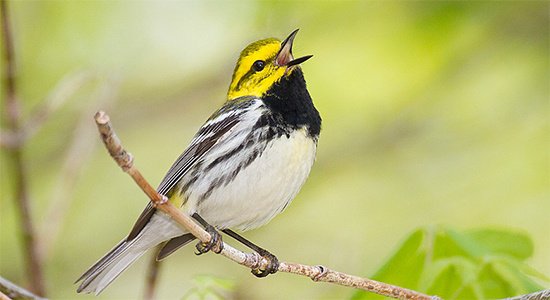
Wrapping it Up with a Feathered Twist
So, there you have it – that morning bird jam isn’t just a random wake-up call. It’s like birds are throwing a party, speaking a fancy language full of love, drama, and tales of survival – it’s like their own avian soap opera!
Imagine this: those chirpy melodies aren’t just random tweets; they’re like birds catching up on the latest gossip – who’s in charge, who’s in love, and who’s just trying to survive the bird drama.
The songs a bird species share. It’s like their life playlist, mixed with evolution vibes and the wisdom of their bird ancestors. They’ve got their own hit tunes passed down through generations.
Now, here’s the funny bit: did you know that some birds mimic human sounds? Yep, they’re out there imitating car alarms, chainsaws, and even your phone ringtone. Imagine a bird choir singing your favorite jingle!
And, hey, next time you’re out for an early walk and hear those chirps, think about this: birds have regional accents, just like us! A city bird might sing a different tune than its country cousin. It’s like bird karaoke with a touch of country twang.
So, as you enjoy the morning bird serenade, take a sec to tune in. Can you hear the laughter in those treetops? Birds might just be cracking jokes we haven’t quite figured out yet.
And wouldn’t it be hilarious if we could understand their language? Nature’s full of surprises, and these feathered friends add a touch of humor and harmony to our daily routine. So, as you groove to their tunes, remember, you’re tuning in to the comedy and drama of the original avian sitcom right outside your window!
FAQs: – Why Do Birds Of Same Species Sing The Same Way?
Q: Why do birds sing similar songs within a species?
A: Birds sing alike due to a mix of shared genetics and learning from each other, helping them communicate effectively.
Q: How do birds learn their songs?
A: Birds learn their songs from older birds during crucial learning periods, ensuring the songs are passed down through generations.
Q: Do birds have different dialects in their songs?
A: Just like people in different regions have accents, birds develop dialects based on where they live, adding a unique touch to their songs.
Q: How do birds use alarm calls?
A: Birds use specific alarm calls to warn each other about different types of dangers, showcasing their advanced social structures.
Q: What can you tell me about the song of the white-crowned sparrow?
A: The song of the white-crowned sparrow is an excellent example of vocal learning and song crystallization in birds. Juveniles learn their songs from adult ‘tutors’, refining and solidifying, or ‘crystallizing’ these songs into a consistent adult version.
Birds Of Same Species Sing In the Same Way
